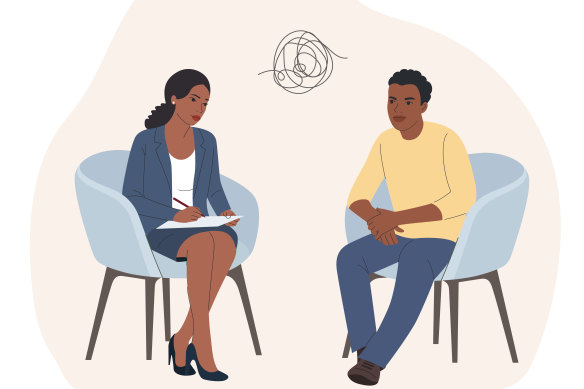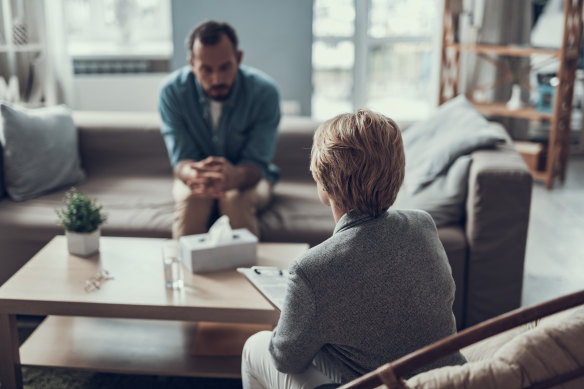This was published 8 months ago
What are Australian men talking about in therapy?
By Staff Writer
For a long time, men were expected to suffer in silence. No matter what they were dealing with, talking about their emotions and asking for support were generally considered signs of weakness. But this perception is slowly changing.
According to therapists and counsellors across Australia, men are increasingly turning to mental health services to improve their behaviours and explore their inner lives. After being expected to bottle it up for so long, what exactly are men addressing in therapy now?

More Australian men are going to therapy these days, but what are they talking about?Credit: iStock
How many men are going to therapy?
Between 2020 and 2022, 21.6 per cent of women aged 16 to 85 said they had seen a health professional about their mental health within 12 months, according to the Australian Bureau of Statistics. Meanwhile, only 12.9 per cent of men did.
“Too many men can feel like they do not need to access psychological support, that ‘things will be okay … I’ll work through it’,” says psychologist and director of the Australian Association of Psychologists Incorporated, Carly Dober. “This isn’t necessarily a bad thing for small situational issues that resolve in time. But people with low mental health literacy may not identify when they need therapeutic intervention, and may inadvertently prolong their suffering.”
However, this is slowly improving. Co-chief executive at Associated Counsellors & Psychologists Joanna Fishman says her clinic has seen about a 3 per cent increase in the number of men seeking counselling over the past five years, with more men, particularly young adults, seeking regular counselling sessions.
“We’re slowly breaking the stigma around men’s mental health, making it easier for them to open up without feeling ashamed,” Fishman says. “When men seek counselling, it benefits not only themselves, but also their partners and children.”

Only 12.9 per cent of men saw a health professional about their mental health between 2020 and 2022. Credit: iStock
Director of Blokes Psychology Carl Nelms notes that the expansion of social media means more public figures, such as sports players, are sharing their mental health struggles, further normalising conversations around men’s wellbeing.
“When Blokes Psychology started, the majority of our clients were coming in when they’d hit a crisis point, whereas now we’re getting more men of all ages coming in before that,” Nelms says. “They’re saying, ‘Things are actually not bad, I just want to be a better father. I want to learn how to express my emotions, or identify more, or just live a more fulfilling, meaningful life’.”
What are they talking about most?
The topics covered in therapy or counselling run the gamut. However, six topics tend to reoccur among men.
1. Loneliness
A survey conducted by men’s health organisation Healthy Male in 2023 found that 43 per cent of Australian men were lonely, with those aged between 35 and 49 experiencing the highest rates.
Dober says therapy encourages men to explore underlying issues, such as societal expectations around masculinity, which can hinder their ability to connect with others on a deeper emotional level. “Addressing these challenges can help men develop healthier interpersonal skills and foster meaningful relationships, leading to improved overall wellbeing.”
2. Identity and masculinity
Nelms says there are many men of all ages who are unsure of what being a man means for them, and what being masculine entails.
“Generations ago, it was much more binary: you’re the provider, this is what men do, this is what men don’t do. That has broadened, which in many ways is great, but in other ways, some men feel as though there’s no place to be a masculine man these days.”
This ambiguity, combined with various everyday challenges, can lead to a form of existential crisis for some men, Nelms says, which can manifest into things like addiction, anger, and anxiety.
3. Depression, anxiety, anger and addiction
Nelms refers to these as the “big four” due to their prevalence among both male and female clients.
According to the Household, Income and Labour Dynamics in Australia Survey in 2021, about 14 per cent of Australian males aged 15 and up experienced anxiety or depression – a 5 per cent increase since 2013. These kinds of conditions can be exacerbated by societal pressures to conform to traditional norms of masculinity, Nelms says.
4. Parenting
As family structures change, Fishman says it has become common for men to explore what kind of father they are, as well as how they can simultaneously support and connect with their children.
“This includes improving communication with children and balancing family needs with self-care,” Fishman explains. “Many fathers aim to better understand and fulfil their role within the family.”
5. Intimacy issues or concerns
Intimacy issues among men, such as performance anxiety, erectile dysfunction and sex addiction, have long been considered “shameful”. “Societal expectations and personal insecurities can compound these issues, making open communication and vulnerability difficult,” Dober says.
However, she notes more men are opening up about their concerns around emotional intimacy and sex, thereby helping them develop healthier attitudes and strengthen their relationships.
6. Separation and divorce
Fishman says men are increasingly turning to therapy to help navigate life after a breakup, examining feelings of grief, failure and loss of identity, as well as more logistical challenges like co-parenting and financial stress. However, they’re also seeking professional advice on how to improve as a partner, or how to enhance a relationship.
What more could be done?
Though the stigma around men’s mental health struggles is being dismantled, Australian Psychological Society president Dr Catriona Davis-McCabe says this has not translated into a significant increase in men using psychology services.
More spaces must be designed specifically for men to express themselves without shame, Davis-McCabe says.
Australians can access mental health treatment plans, which provide up to 10 individual sessions with mental health professionals each year. “A big part of the solution is reducing gap fees and wait times and reinstating 20 sessions for those who need it,” Davis-McCabe says.
“When most people need 16 to 20 sessions for treatment, many men rightly ask themselves, ‘Even if I can afford it, what’s the point of seeing a psychologist if I can only get 10 sessions per year?’”
Make the most of your health, relationships, fitness and nutrition with our Live Well newsletter. Get it in your inbox every Monday.